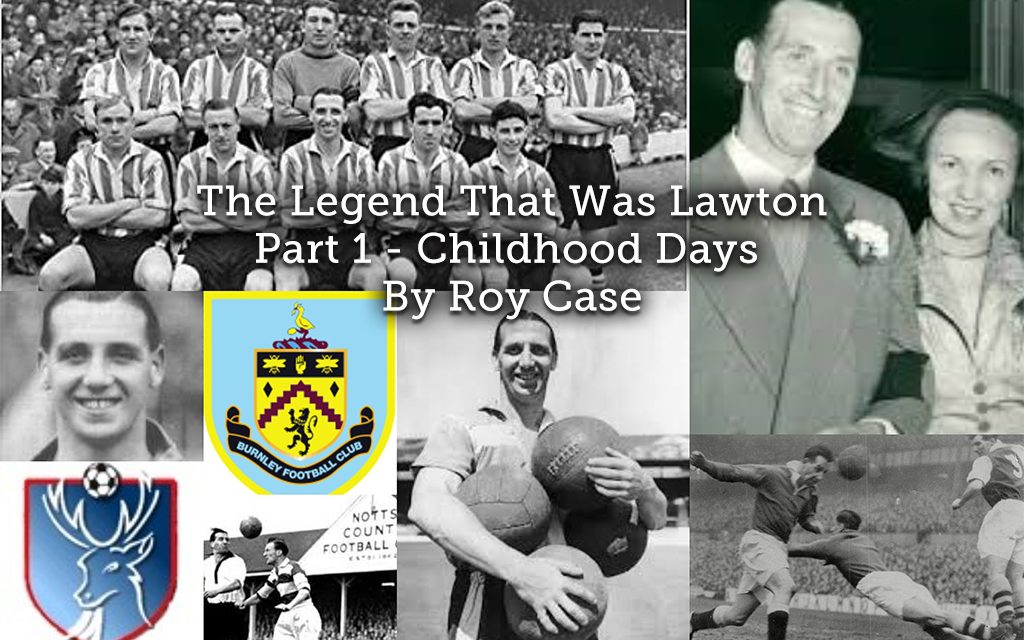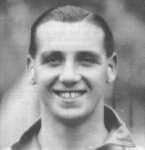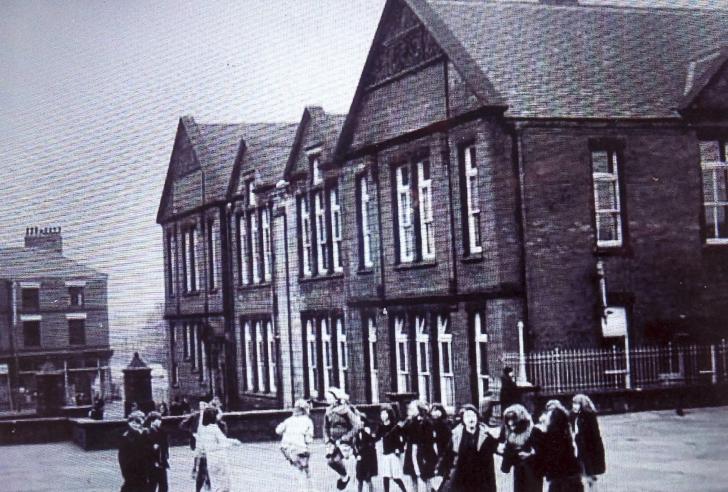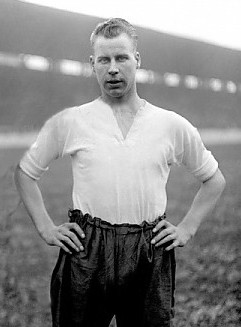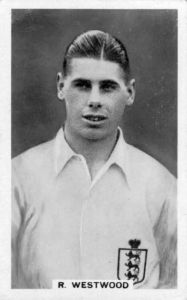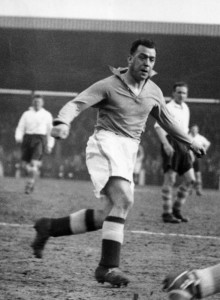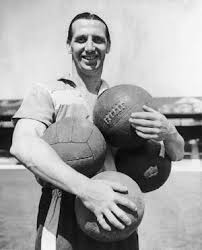Tommy Lawton was born on the 6 October 1919, in the Lancashire coal-mining community of Farnworth, situated on the banks of the river Irwell, a couple of miles south-east of Bolton, Greater Manchester.
We will never really know if Lawton was the greatest centre-forward ever to pull on an England jersey, but what we do know is that he played in an era which was totally different from that of today. When in an entire career which lasted for two decades, he never earned as much as many of the leading football stars of today earn in a week!
His father, Thomas Lawton, a signalman of Irish extraction, worked on the Lancashire and Yorkshire railway, while his mother, Elizabeth Riley, was a cotton weaver at the nearby Harrowby Mill. Just 18 months after Tommy was born his father upped and left, forcing Elizabeth to move back to her parent’s home, a two-up two-down terraced house off the Folds Road, near the centre of Bolton, where her father, James Riley, assumed the role of surrogate father to the toddler Tommy.
Riley himself was a football fanatic and decent amateur player, who assiduously encouraged his four sons to also play the game. With his mother working a 12-hour shift at the mill, young Tommy devoted a great deal of his spare time playing football with his grandfather and four uncles. ‘We made goalposts with coats and jackets,’ Tommy would later reveal, ‘and we’d just play any time of the day’.
As far as Tommy could remember he had always been interested in the game, and as a youngster in Bolton, would play whenever, and wherever, he could, sometimes with a tennis ball, sometimes with a ‘rag ball’, and from time to time, even with a real football.
The sports master at the Tonge Moor Primary Council School, East Bolton, a meticulous Bunny Lee, was quick to recognise Tommy’s sporting ability, spotting that, even as a young boy of eight, Tommy had quite a shot with his right foot, but only used his left one for standing on. And since only the best would do for the scrupulous Mr. Lee, he would keep the fanatical Tommy back after school and haul him back out to the playing field and make him practise shooting using his left foot.
‘I had never been able to kick a ball with my left foot,’ Tommy confessed, ‘but every afternoon at four o’clock after school, he took me across to the field and we practised shooting and passing with a plimsoll on my right foot and a boot on my left. He would kick the ball across to me and I had to shoot from whatever angle. It was tough going, but my, was it worth it !’
When he was 9 years old, young Lawton left the Tonge Moor Council School, and moved to the recently built Castle Hill School. Fortunately, the headmaster there, Fred Milner, was also keen on football, and continued to help coach the talented Tommy.
But it would not be long before he was on the move again, this time to the Folds Road Central School, where one of the very first questions Tommy was asked by the inquisitive ‘Pop’ Lever, the headmaster, and devoted soccer enthusiast, was ‘whether he played football’. When Tommy confirmed that he did, a trial for the school team was hastily arranged, and before long he was not only leading the school attack, but also that of the Bolton representative side as well.
- Folds Road School
Lever was a staunch supporter of the game and used to watch the boys kicking a ball around in the school-yard during their break. The lads would chalk up set of replica goal posts on the school wall and develop their shooting and heading skills using a tennis ball. If he thought one of the lads needed a little constructive advice, he would call him over to his study window, offer a few pearls of soccer wisdom and settle back to watch some more.
In those days, football was a ‘religion’ for most of Lancashire’s men folk, much as it remains today for most people in the industrial North. And goal posts chalked on walls was a common enough sight in and around Bolton when Lawton was a lad. When shooting-in was one of the highlights of a youngster’s day. But it was Tommy’s grandfather, Jimmy Riley, who influenced him the most.
‘He was my staunchest admirer and pal. He nursed and advised me and was one of the main reasons why I was able to get such a great start in football’.
From the age of ten Lawton would turn out, every so often, for his grandfather’s team.
‘On Sunday mornings, after church, there was usually a game organised against a team from another part of Bolton, with side-stakes. We would get a ‘tanner’ a man if you were on the winning side’.
(A ‘tanner’ [2½ pence] would pay for their Saturday night out, along with a couple of pints and a packet of fags.)
By 1930 Lawton’s natural football ability had earned him a place in the Bolton Town school side, and at the age of thirteen he was selected to play for Lancashire Schools. And yet he never won an England cap as a boy, even though he scored a hat-trick in a trial match for England Schoolboys, he was not selected for the impending match against Scotland.
‘I was never capped at schoolboy level,’ he later proclaimed. ‘I can’t understand why not. It was one of the biggest disappointments of my life’.
Although a dedicated supporter of Bolton Wanderers, as a youngster, Tommy was never blessed with enough ready cash to be able to afford to watch them play. And in common with so many other young lads, he would scamper into the stadium to enjoy the last bit of the ‘Trotter’s’ matches free of charge, when the gates were thrown open for the second-half. His great heroes of the time were, the former captain Harry Goslin, and inside-forward Ray Westwood, uncle of the legendary Manchester United wing-half Duncan Edwards, who was tragically killed in the 1959 Munich air disaster. However, the man Tommy tried best to emulate was the celebrated Dixie Dean, predominately known for scoring with his head, and who played most of his career with Everton.
- Harry Goslin
- Ray Westwood
- Dixie Dean
By the time he reached the school-leaving age of fourteen Tommy was scoring goals for fun playing on Saturday afternoons with Hayes Athletic in the Bolton Senior League and collecting a grand total of 570 goals in a spell of three seasons.
Although in those days, the Football Association’s rules decreed Tommy could not sign professional forms until he was 17, he was offered work as a delivery boy for Bolton Wanderers at seven shillings and sixpence a week [37½ pence] until he was old enough to join the playing staff and sign professional forms for the club.
 However, his grandfather, Jimmy Riley, who was nominated to negotiate as Tommy’s representative, rejected the offer. As a result, he chose to play as an amateur for the semi-professional Rossendale United FC in the Lancashire Combination league, and in his debut match against Bacup Borough FC he scored a hat-trick for the ‘Stags’. Founded in 1898, Rossendale endured an eventful history, before it was finally dissolved in 2011.
However, his grandfather, Jimmy Riley, who was nominated to negotiate as Tommy’s representative, rejected the offer. As a result, he chose to play as an amateur for the semi-professional Rossendale United FC in the Lancashire Combination league, and in his debut match against Bacup Borough FC he scored a hat-trick for the ‘Stags’. Founded in 1898, Rossendale endured an eventful history, before it was finally dissolved in 2011.
It wasn’t long before other influential clubs took an interest in the teenage Tommy, and Sheffield Wednesday made an offer to sign him as an amateur. But his mother soon put a stop to that and turned down a proposed deal of of ten shillings [50 pence] a week and the promise of a job later, as she was fearful for him making the daily journey to Sheffield. He later took up temporary work at a tannery, before joining Burnley FC as an assistant grounds-man.
Before signing professional forms with Burnley, Tommy also turned out as a batsman with the Burnley Cricket Club. Amassing an aggregate total of 369 runs from 15 innings for the club, which included clouting both Learie Constantine and Amar Singh for six. One of the most successful club teams in Lancashire League history, Burnley Cricket Club can lay claim to having generated a plentiful supply of first-class cricketers, including the current ‘King of Swing’, James Anderson OBE, widely regarded as one of the finest fast bowlers of his generation.
Article © Roy Case
For Part 2 see – bit.ly/2OVewb
For Part 3 see – bit.ly/2I57W1x
For Part 4 see – bit.ly/2G6VGeQ

